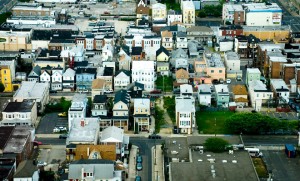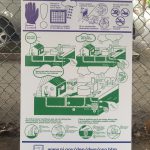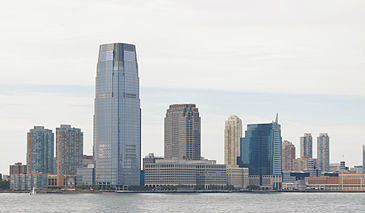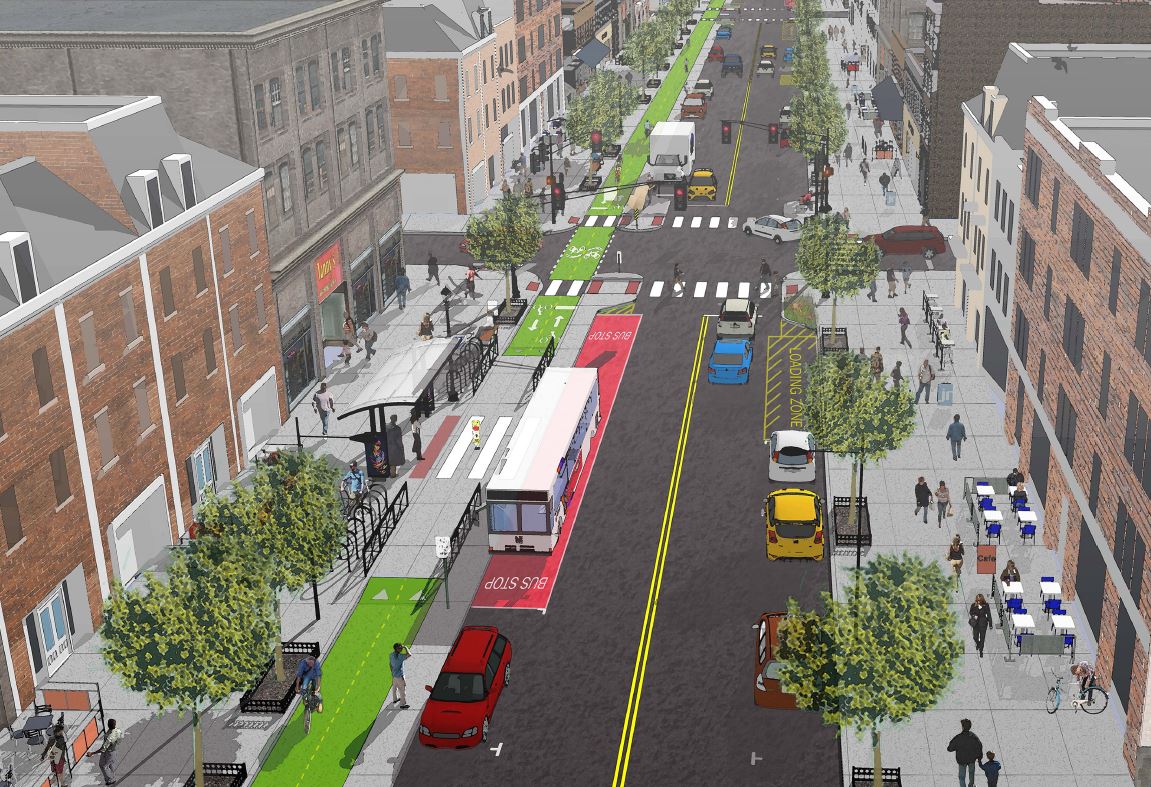New Jersey Future Blog
Does New Jersey Have Room to Grow?
January 26th, 2012 by Tim Evans
 Of New Jersey’s 566 municipalities, more than half (328) had fewer residents as of the 2010 Census than they had at some time in the past, even though the state’s overall population is the largest that it has ever been.
Of New Jersey’s 566 municipalities, more than half (328) had fewer residents as of the 2010 Census than they had at some time in the past, even though the state’s overall population is the largest that it has ever been.- If the population of each of these 328 municipalities were to return to its historical maximum, an additional 760,000 people could be absorbed.
- About 40 percent of this absorption number, or 302,000 people, could be accommodated in just six cities designated as “urban centers” by the State Plan: Newark, Jersey City, Paterson, Trenton, Camden, and Atlantic City. The land in these cities is already fully developed, so restoring them to their peak populations would involve redeveloping vacant and underutilized sites, rather than building on virgin land. (The other two urban centers identified in the State Plan, Elizabeth and New Brunswick, actually have more residents today than at any earlier time, so they do not contribute to the shortfall.)
- More generally, two-thirds (217 out of 328) of the municipalities that presently have fewer residents than at their peak are primarily “built out,” meaning that, based on 2007 data, at least 90 percent of their land area was already developed. These places lost population but retained their developed land, so they could be repopulated simply be refilling that land to its prior capacity.
Absorbing New Population Through Redevelopment
Extrapolating population projections from the Census Bureau and the New Jersey Department of Labor indicates New Jersey will gain about another 1 million residents by approximately 2042, 30 years from now. The question is, where will we put them?
One possible answer involves the standard “greenfield” model – that is, continuing to build on our undeveloped lands until everything is either developed, permanently preserved as open space, or undevelopable because of environmental constraints. As of 2007, New Jersey had just under a million (992,000) acres of developable land remaining. If recent land development trends continue – between 2002 and 2007, New Jersey developed 873 acres for every 1,000 net new residents – then accommodating a million new people will entail developing an additional 873,000 acres. This is nearly the entirety of the state’s remaining supply of developable land. We’ll be very close to full build-out.
But what if we put the old model aside and instead considered an alternative? What if we seek to accommodate as much new growth as possible without having to develop any new land at all?
It turns out we could get three quarters of the way toward absorbing the next million residents simply by repopulating to their historical peak populations all of New Jersey’s municipalities that currently have fewer residents than at some point in the past. In principle, this would not have to involve any additional land development at all, since these municipalities were all able to house larger populations on the same or fewer developed acres. Substantial population growth can be accommodated through redevelopment: by reconfiguring or repurposing existing buildings, by building on surface parking lots or previously developed but now vacant sites, or by razing obsolete structures and building new ones.
These redevelopment opportunities are almost everywhere, based on empirical evidence. For example, municipalities that were already at least 90 percent built-out as of 2002 accounted for a full one-third of the building permits issued statewide from 2000 to 2009. (See New Jersey Future’s report Built Out but Still Growing for a more complete analysis of this building permit activity.) Between 2000 and 2010, a group of 95 municipalities that were already at least 90 percent built-out in 2002 collectively gained 91,000 residents.
Clearly, the fact that a place has already built on most of its land does not imply that it can no longer increase in population. A strategic focus on redevelopment means that New Jersey can absorb plenty of new growth and still do justice to the “garden” part of its Garden State nickname.
New Jersey Future will focus on effective strategies to redevelop these areas at its annual Redevelopment Forum March 9. Please join us for a day of workshops, learning and networking, all about issues affecting redevelopment efforts in the Garden State.

















As mayor of one of the 328 towns that had fewer residents in 2010 then in 1980, I would like to point out one fallacy in your analysis, although I agree in principle with your argument:
True, our population decreased, BUT OUR HOUSING STOCK INCREASED, as did, therefore, our developable land (of which there is virtually none left). The primary reason our population decreased is because families are smaller. Though houses are larger, fewer people live in them. Contrary to what the media report, there are actually fewer multi-generational households, and certainly fewer school children.
You are absolutely right, of course, that today’s household sizes are smaller than 50 years ago (when a lot of NJ’s cities and older suburbs peaked in population), so to house the same number of people today as back then would involve more housing units. But I didn’t want to get bogged down in details. The idea was to demonstrate that these past-peak municipalities empirically have the capacity to accommodate more people than they’re currently accommodating, even if there are pragmatic obstacles to be overcome if we were actually going to try to repopulate them to their historical maximums. Those obstacles can be overcome if the will is there. But yes, my scenario was (out of a desire for brevity) admittedly a bit of a simplification.
I disagree with your premise that increased population is inevitable and must be accommodated. Population has already decreased to a point where we are losing one seat in Congress, a very significant population bench mark. I suggest that the current population level is unsustainable and the cause of the current massive social austerity problems in NJ, and that further population reductions are both inevitable and will be beneficial to the long term prosperity of New Jersey. I also suggest that we should learn how to plan to achieve prosperity without growth for a sustainable future, rather than how to jamb more unsustainable, uneconomical growth into our state given it’s finite economic, ecological, and social resources. For more on the concept of prosperity without growth, go to http://www.guardian.co.uk/books/2010/jan/23/properity-without-growth-tim-jackson
New Jersey has gained population every decade since the first Census was conducted in 1790. So while it may not be true that population growth is inevitable, it has nonetheless been constant. The reason New Jersey is losing a Congressional district is that the number of districts nationwide is fixed, while New Jersey has been growing more slowly than other parts of the country, so that its proportion of total U.S. population is shrinking. But New Jersey’s population itself is not shrinking.
I am a resident of a Village in the Pinelands National Reserve (PNR) where redevelopment officially began in October 2006, although the municipality had already completed a good part of their work between 2004 and 2006 – with much controversy. Agreed, redevelopment can be a useful land-planning tool as you suggested, for example by “reconfiguring or repurposing existing buildings…,” etc. However, at Richland Village (and nearby Comar Place) wetlands, original woods with T&E species, agricultural land, and historic structures were deemed blighted and in need of redevelopment. While I realize that a 2003 amendment to the Local Development and Redevelopment Law (LD&RL) provided an “absurdly vague criterion for designation of an ‘area in need of redevelopment’” (Kinsey, 2008: 7), the LD&RL does not to the PNR. There are 47 Pinelands Villages on 26,000 acres, which are slated to become Priority Funding Areas with redevelopment. The Pinelands Commission recently stated they were “obligated” to water and sewer these areas in support of growth. Is this a proper use of redevelopment, or antithetic to your suggestions?
Mark, I am not familiar with the site that you mention, so I can’t comment specifically on the redevelopment proposal for Richland Place. However, there does seem to be a disconnect between the basic definition of “REdevelopment” – developing something on land that has already been built on – and your description of the redevelopment plan for Richland, which involves redeveloping “wetlands, original woods with T&E species, agricultural land”.
Chris,
Thank you for your response. Agreed, there is a disconnect between redevelopment’s spirit and its application in the Pinelands. Since New Jersey Future’s mission is to “promote responsible land-use policies,” what is your position when leaders act irresponsibly? Can you help me protect natural lands and farms from becoming sprawl in the Pinelands National Reserve, or are you an advocacy-only group?
Mark
This is a clear indication of how ridiculous and discredited the concept of “build out” is. It has no validity in the planning literature, and only people who confuse zoning with planning would take it seriously. The entire history of human civilization is one very long case study of redevelopment and rebuilding. The built environment is never static, unless it is dead. Even in places designated by UNESCO as world heritage sites — where historic preservation concerns are a top priority — there is considerable redevelopment and new construction. That’s why they stay healthy and vibrant.
Discussions of “build-out” are meaningless and will not advance the redevelopment agenda. If the intention is to show that NJ can grow substantially simply by attracting new jobs and residents to existing built places, then the focus should be on what is preventing that from happening now and what public policy can do to encourage it.
Carlos — “Build-out” is a meaningful concept if you’re talking about how close a state is to having built on all of its developable land. From a land-development standpoint, full build-out comes when the number of undeveloped but still developable acres in the state reaches zero — that is, the point at which every acre in the state has either had something built on it or is undevelopable, whether because of environmental constraints or because it’s been permanently preserved as open space. Once a state has reached build-out, any further development is going to have to be redevelopment, because there’s no longer any undeveloped land that can be built on.
But if your problem with “build-out” is its use to imply that no more growth is going to happen after that point, then I agree the concept is meaningless. Civilizations have always re-used lands whose initial uses have become obsolete, and we will continue to do so. Sometimes previously-developed land even reverts to nature — check out some of the ghost “towns” in the Pine Barrens for examples. “Built out” does NOT imply “full.” (After all, Manhattan island has been completely built-out for many decades now, yet it continues to grow.)
Excellent article, Tim. I am just back from a trip to Hong Kong, Singapore, Australia and New Zealand where they face the same pressures. I especially liked your statement, “What if we seek to accommodate as much new growth as possible without having to develop any new land at all?”
Here in Haddon Heights we have almost the same housing stock since 1960 yet out population declines as families get small AND, and this is big, single men and women buy houses and seniors stay in their houses much longer. We must do more to rebuild the six urban centers and do it now!